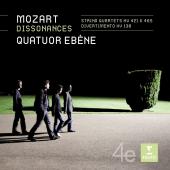Mozart: String Quartets K 421, 465
Label: VIRGIN Catalog: 5099907092220 Format: CD Ebene Quartet1. Allegro moderato- String Quartet No.15 in D Minor KV421 2. Andante- String Quartet No.15 in D Minor KV421 3. Menuetto & Trio- String Quartet No.15 in D Minor KV421 4. Allegretto ma non troppo- String Quartet No.15 in D Minor KV421 5. I. Allegro- Divertimento in F Major KV 138 6. II. Andante- Divertimento in F Major KV 138 7. III. Presto- Divertimento in F Major KV 138 8. I. Adagio - Allegro- String Quartet No.19 in C Major KV465 'Dissonance' 9. II. Andante cantabile- String Quartet No.19 in C Major KV465 'Dissonance' 10. III. Menuetto (Allegretto) & Trio- String Quartet No.19 in C Major KV465 'Dissonance' 11. IV. Allegro molto- String Quartet No.19 in C Major KV465 'Dissonance' The Ebène Quartet’s fourth Virgin Classics release brings works that lie close to the origins of string-quartet writing – Mozart’s so-called ‘Haydn Quartets’. “It’s such amazing music, so rich and filled with such subtlety; completely unpretentious, yet of such genius,” says the Ebène’s first violin, Pierre Colombet. After their multi-award-winning Virgin Classics debut with a CD of Debussy, Ravel and Fauré, a programme of Brahms, and the pop-jazz collection ‘Fictions’, the members of the Ebène Quartet turn to works that lie close to the very origins of string-quartet writing – Mozart’s so-called ‘Haydn Quartets’. Composed in 1785, the set of six quartets was dedicated by Mozart to his friend and mentor Haydn, the acknowledged ‘father’ of the string quartet. The most famous of the set is the quartet in C major, KV 465, the ‘Dissonance’. It opens with a mysterious introduction, with layered harmonies creating the dissonance that gives the quartet its distinctive nickname. It is coupled with the quartet in D minor, KV 421 (another of the ‘Haydn Quartets) and the Divertimento in F major KV 138, written when Mozart was a teenager. Pierre Colombet, first violin of the Quatuor Ebène explains the ensemble’s approach to Mozart: “We felt that, after Fictions, it would be a good idea to choose something really very classical, essential quartet music which went back to the roots of the quartet. We made a Haydn disc for another label some time ago, and we felt we just had to do some Mozart now. Yes, we’ve been playing Mozart for a very long time, but over the past year or two, we’ve felt more and more of a need to do it – it’s such amazing music, so rich and filled with such subtlety; completely unpretentious, yet of such genius. And as Mathieu Herzog, the quartet’ viola vividly confesses: “It’s hardly news that classical musicians consider Mozart one of the most difficult composers to interpret, to play, to realise … you have to invest yourself constantly in his music and it’s very powerful, very tough on your emotions. And you have a weight on you – more like a layer of concrete on your head – because you want to succeed in delivering a new vision of the composer … We’re following in the footsteps of people who have played his music so very, very well and we want to respect Mozart for what he is. The whole thing is as hard as dancing Swan Lake in Caterpillar boots, but it’s worth the effort. Pierre Colombet explains the title of their new release : “It might seem a bit of a paradox to call a Mozart disc ‘Dissonances’, even though he did write a quartet which is known as the ‘Dissonance’, but beyond that it’s true that Mozart’s music has loads and loads of very complex harmonies, sounds which create friction with each other. Ebène’s cello Raphaël Merlin on the quartet’s interaction “When we’re playing Beethoven, Bartók or our jazz or pop repertoire, we use our instruments in a way that’s more percussive, that is more about the pressure we apply. But with Mozart it’s a matter of finding a natural resonance in our instruments, of letting them express themselves … almost of letting them communicate with each other in order to find the right resonance for this music. There is a phenomenon of sympathy – when the wood of an instrument’s soundbox vibrates and causes a vibration in the wood of an instrument close by. It’s that harmony that must link our instruments and that we ourselves must feel. It’s a very, very sensitive matter.”  Price: $21.98 Price: $21.98 |












